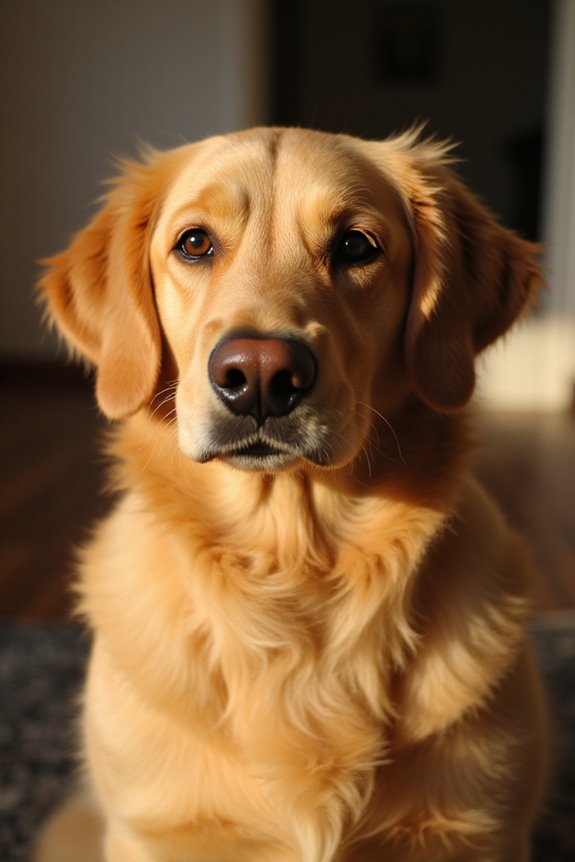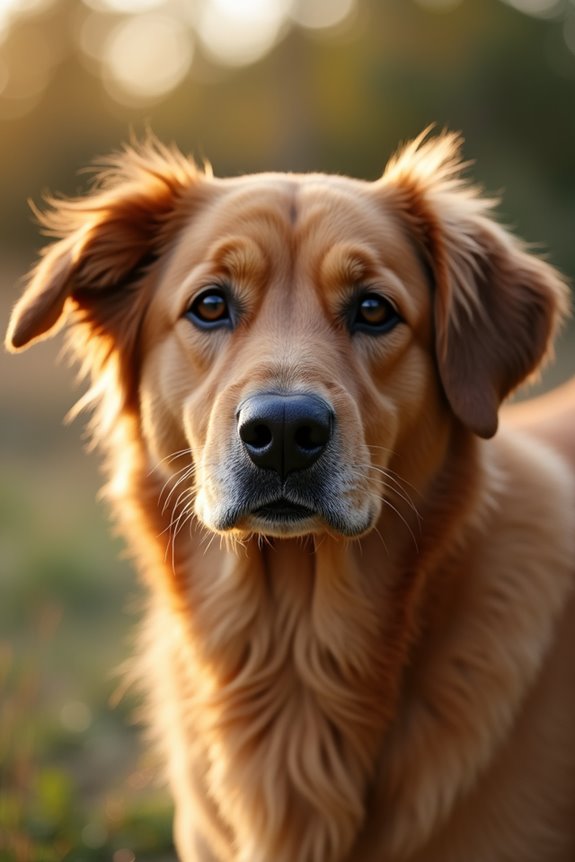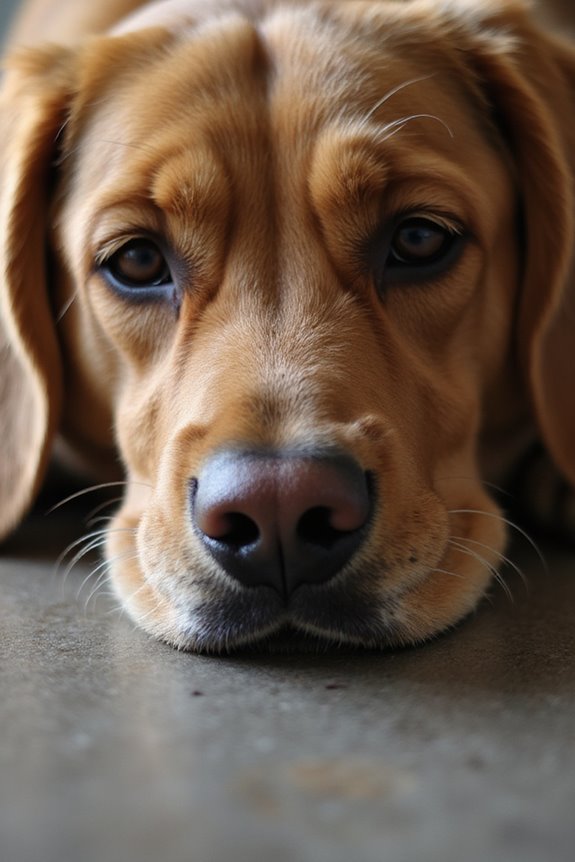Many decorations can be toxic to dogs. Common toxic plants include Pothos, Philodendron, and Dieffenbachia, which may cause oral irritation or swelling. Electrical cords pose risks for severe burns or shocks if chewed. Cocoa mulch is harmful due to theobromine, and hazardous ornament materials like small items, ribbons, and balloons can lead to choking. Always check your decorations for safety, and keep hazardous items out of reach to guarantee a safe environment for your pet. More information follows.
Key Takeaways
- Pothos, Philodendron, and Dieffenbachia can cause oral irritation and digestive issues if ingested by dogs.
- Azaleas can lead to vomiting and cardiac failure in dogs, posing severe health risks.
- Salt Dough Ornaments are hazardous due to high salt levels, risking vomiting and kidney damage.
- Electrical cords can cause severe burns and electric shock if chewed; ensure they’re secured and monitored.
- Cocoa mulch contains theobromine, toxic to dogs, and should be avoided in accessible areas.
Toxic Plants Commonly Used in Decorations
When considering decorative options for your home, it’s essential to be aware of the toxic plants that frequently adorn our spaces, particularly if you have dogs. Many popular toxic houseplants can cause serious health issues for your furry companions. For example:
- Pothos and Philodendron cause oral irritation and digestive distress.
- Dieffenbachia, also known as Dumb Cane, can lead to painful swelling.
- Peace Lily can irritate the throat, leading to discomfort.
In addition, several decorative flowers pose risks. Azaleas, for instance, can trigger vomiting and even cardiac failure in dogs.
To keep your pets safe, always research the toxicity of houseplants and flowers before bringing them home. Immediate veterinary care is essential if ingestion occurs.
Hazardous Ornament and Decoration Materials
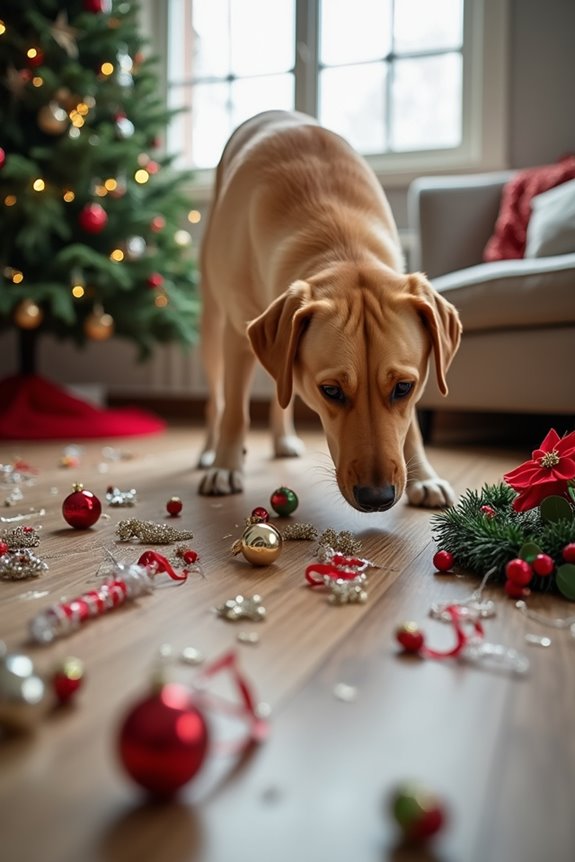
Understanding the potential hazards associated with decorative materials is essential for dog owners who want to guarantee a safe environment for their pets.
Many common decorations pose risks, such as:
- Salt Dough Ornaments: High salt levels can cause severe health issues, including vomiting and kidney damage if ingested.
- Choking Hazards: Small items like decoration hooks and broken baubles may lead to choking or gastrointestinal trauma if swallowed. Similarly, ribbons and balloons can also pose serious risks.
To protect your dog, it’s vital to remove or securely place these decorations out of reach. Inspect all ornaments before the holidays and choose safer alternatives. Preventing accidental ingestion is key to keeping our furry friends healthy during festive times.
Risks Associated With Electrical Decorations
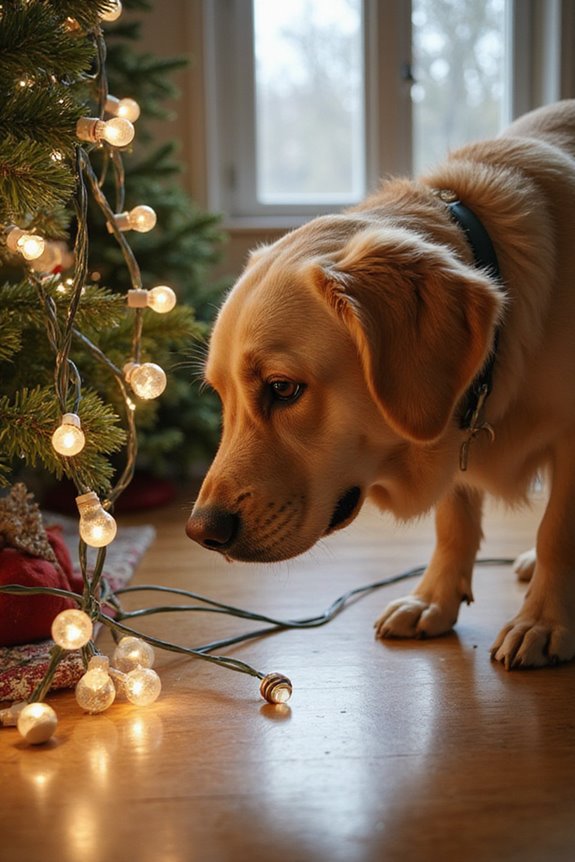
Electrical decorations can pose significant risks to dogs, especially during the holiday season when these items are more prevalent and enticing. Many pets, out of curiosity or boredom, may chew on live electrical cords. This can lead to severe oral burns and even fatal electrical shocks, triggering seizures in vulnerable pets.
To guarantee electrical safety, consider the following holiday precautions:
- Unplug decorations when not in use or when pets are left unsupervised.
- Regularly inspect cords for frays or damage and replace them promptly.
- Use cord protectors or battery-operated decorations as safer alternatives.
- Create pet-free zones for areas adorned with decorations to minimize risks.
Dangerous Mulches and Chemicals Around Decorations
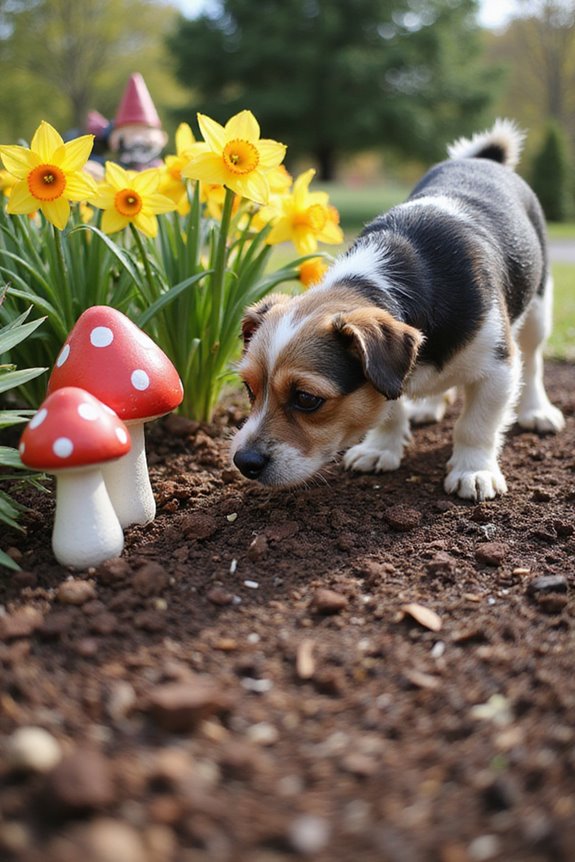
As we decorate our homes for special occasions, it’s crucial to recognize that certain mulches and chemicals used around ornamental decorations can be dangerously toxic to dogs. Cocoa mulch, for instance, contains theobromine, which is far more concentrated than in chocolate. Pesticide exposure is another concern; certain mulches may harbor residues that linger long after application, posing ingestion risks.
The potential for mold also exists, with some producing mycotoxins that can lead to seizures. Here are key points to take into account:
- Avoid cocoa and chemically treated mulches near accessible areas.
- Monitor your dogs closely in mulched gardens.
- If ingestion occurs, contact a veterinarian with mulch samples for prompt care.
Being proactive can help guarantee our furry friends stay safe.
Physical Hazards Posed by Decorative Items
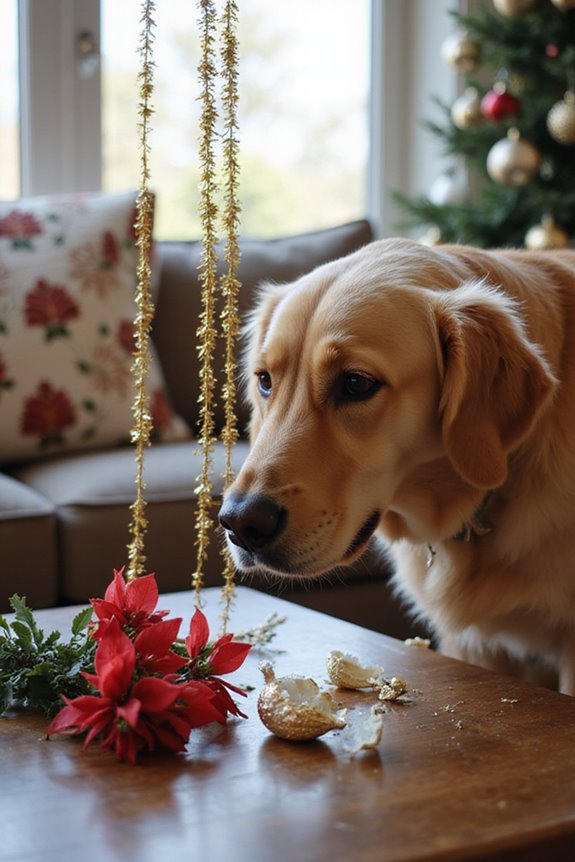
The presence of decorative items in our homes can also introduce physical hazards for dogs, which is a concern that warrants attention. Here are some potential holiday hazards to take into account for ornament safety:
- Glass Ornaments: These can shatter, causing cuts and even internal injuries if ingested. Sharp edges pose risks if chewed.
- String-like Decorations: Tinsel, garland, and ribbons can lead to severe intestinal obstructions if swallowed, often requiring emergency surgery.
- Electrical Cords and Holiday Lights: Chewing can result in electric shock, and damages can increase risks.
- Edible Decorations: Salt-dough ornaments may lead to salt toxicity if ingested.
- Potpourri and Essential Oils: These can cause chemical burns, gastrointestinal upset, and respiratory distress.
Taking precautions helps guarantee our dogs stay safe from these hidden dangers during the festive season.
Common Behavioral Issues Related to Decorations
While decorative items can enhance our living spaces during festive seasons, they can also lead to a variety of common behavioral issues for dogs. Many decorations serve as barking triggers; noise-making items or flickering lights can provoke excessive vocalization, indicating anxiety rather than aggression.
To address chewing behaviors, it’s essential to focus on chewing prevention. Items that gleam or dangle often capture a dog’s attention, triggering curiosity and potential destruction. This can be mitigated by providing engaging chew toys and ensuring decorations are out of reach.
In addition, rearranging the environment can create stress, leading to digging and other anxious behaviors. Recognizing these issues is vital in maintaining a harmonious atmosphere for both dogs and their owners.
Signs of Toxicity in Dogs
Decorative items can pose a serious risk to our dogs, making it important to recognize the signs of toxicity that may arise from their exposure. Watch closely for vomiting symptoms, which are often an initial reaction to ingested toxins. Loss of appetite may accompany this, along with pale or yellowish gums, indicating potential anemia. You might also notice excessive thirst or urination, suggesting kidney stress. Neurological signs are critical to monitor as well; lethargy, an unsteady gait, or seizures can signal severe reactions. Additionally, abnormal behaviors, like agitation or disorientation, often point to toxicity. If you observe any of these symptoms, seeking veterinary attention promptly is essential for your dog’s safety and well-being.
Tips for Creating a Pet-Safe Holiday Environment
Creating a safe holiday environment for your dog is essential, especially considering the various hazards that can accompany festive decorations. To guarantee a pet-friendly atmosphere, follow these tips:
- Use Pet Safe Alternatives: Opt for artificial decorations and non-toxic plants instead of traditional ones.
- Secure Electrical Cords: Prevent chewing by neatly fastening cords and lights.
- Supervise During Holidays: Always observe your dog closely around decorations and food, redirecting them as necessary.
- Store Hazardous Items Safely: Keep batteries, small ornaments, and wrapping after use, making sure they are out of reach.
- Provide Safe Chews: Offer designated toys to distract your pet from risky items.
Implementing these precautions will help create a joyful and safe holiday experience for both you and your dog.
Frequently Asked Questions
What Should I Do if My Dog Eats a Toxic Decoration?
If my dog eats something toxic, I’d quickly contact poison control and an emergency vet. I’d share details about what they ingested and observe for symptoms, staying calm while preparing to act. Your pup’s safety matters!
How Can I Identify Safe Decorations for Pets?
Finding safe decorations for my pets feels like searching for a needle in a haystack! I always choose safe materials and pet-friendly designs, ensuring everything’s sturdy, free of hazards, and away from curious paws.
Are There Pet-Safe Alternatives to Traditional Holiday Decorations?
I love using pet-friendly ornaments and safe holiday lights. It makes decorating stress-free! You can even add some cheerful, edible decorations like apple slices, keeping my furry friends happy and safe during the festivities.
Can My Dog Be Allergic to Decorations?
Absolutely, my dog’s sensitivity to decoration materials can trigger allergy symptoms. I’ve seen sneezing and itching during festive times, so I’m careful about what I bring into our home to keep him comfortable and safe.
What Are the Long-Term Effects of Toxic Ingestion in Dogs?
You know, I never thought a single toxic ingestion could lead to long-term health issues for my dog. I’ve noticed behavioral changes over time—it’s heartbreaking. We’ve got to be vigilant about their safety!

